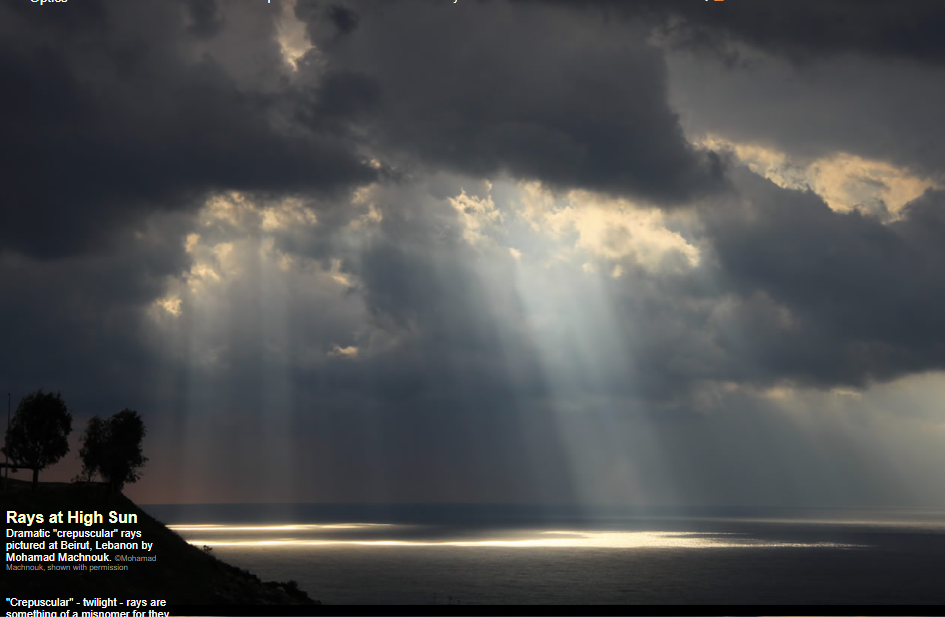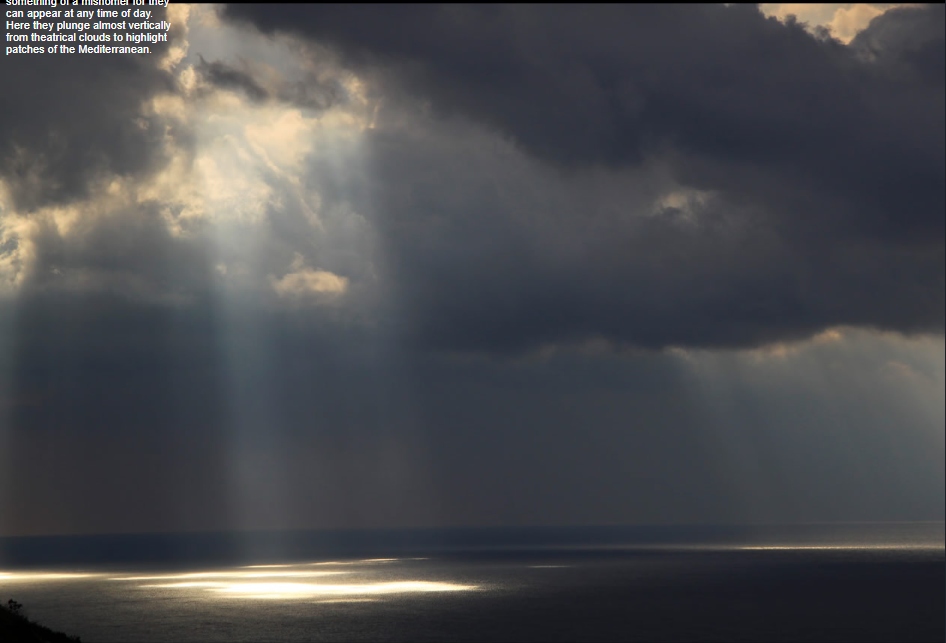OPOD - Lebanon Spotlights
OPOD - Lebanon Spotlights: Captivating Crepuscular Rays
Crepuscular rays, also known as twilight rays, are a mesmerizing atmospheric phenomenon that can appear at any time of day. These ethereal beams of light create a spectacle of nature that captivates observers worldwide. In this edition of OPOD (Optics Picture of the Day), we turn our attention to Lebanon, where photographer Mohamad Machnouk has beautifully captured the enchanting crepuscular rays in the skies above Beirut.
The Splendor of Crepuscular Rays
The term "crepuscular" originates from the Latin word "crepusculum," meaning twilight. While these rays often grace the skies during dawn and dusk, they can actually manifest themselves at any time when atmospheric conditions are just right. Mohamad Machnouk's stunning photograph showcases the rays plunging almost vertically from dramatic clouds, delicately illuminating patches of the Mediterranean Sea. The result is a breathtaking display of light and shadow, adding an ethereal touch to the landscape.
Atmospheric Optics Delights
Atmospheric optics encompasses a wide range of fascinating phenomena that occur in the Earth's atmosphere. From rainbows and halos to mirages and crepuscular rays, these optical marvels continue to astound and captivate both scientists and casual observers alike. Crepuscular rays, in particular, hold a special allure due to their elusive nature and the sheer beauty they bring to the sky.
The Science Behind Crepuscular Rays
Crepuscular rays occur when sunlight is partially blocked by objects such as clouds, mountains, or buildings. The rays appear to radiate outward from the obscured source, creating a fan-like pattern in the sky. This effect is caused by a combination of perspective and scattering of sunlight by tiny particles in the atmosphere, such as dust or water droplets. The rays appear more pronounced when the particles are more abundant, as they scatter the sunlight and make it visible to our eyes.
A Play of Light and Shadow
The interplay of light and shadow is a key factor in the mesmerizing effect of crepuscular rays. As sunlight filters through gaps in the clouds or other obstacles, the shadows cast by these objects create distinct columns of darkness. The illuminated areas between these shadows become the rays themselves, appearing to converge towards a point on the horizon known as the antisolar point. This convergence creates a sense of depth and perspective, enhancing the visual impact of the rays.
Atmospheric Conditions and Crepuscular Rays
While crepuscular rays can occur at any time of day, certain atmospheric conditions enhance their visibility and intensity. The presence of clouds is crucial, as they serve as the canvas on which these rays are painted. Tall, towering cumulus clouds or stratocumulus clouds with well-defined edges are particularly conducive to the formation of striking crepuscular rays. The angle of the sunlight also plays a role, with lower sun angles during sunrise or sunset often producing more prominent and vibrant rays.
Global Appeal and Cultural Significance
Crepuscular rays have captivated cultures around the world throughout history. These celestial beams have been interpreted differently across various societies, often holding symbolic or spiritual significance. In some belief systems, crepuscular rays are seen as divine light or pathways to the heavens. Regardless of cultural interpretation, the universal appeal of these rays lies in their ability to inspire awe and wonder in those who witness their ethereal beauty.
Capturing the Moment
Photographers like Mohamad Machnouk have a keen eye for atmospheric optics and are skilled at capturing these fleeting moments of natural beauty. Through their lenses, they freeze time and preserve the enchanting interplay of light and shadow for all to admire. Machnouk's photograph of the crepuscular rays over Beirut serves as a testament to the power of photography in immortalizing the ephemeral and showcasing the wonders of the natural world.
A Reminder of Nature's Splendor
The captivating crepuscular rays captured in Mohamad Machnouk's photograph remind us of the awe-inspiring beauty that can be found in our everyday surroundings. These transient displays of light and shadow serve as a gentle reminder to pause, appreciate, and marvel at the wonders of nature. Whether it be a dramatic sunrise or a breathtaking sunset, moments like these connect us to the vastness of the universe and evoke a sense of wonder that transcends time and place.
Conclusion
Crepuscular rays continue to fascinate and inspire observers worldwide. Through their elusive nature and captivating beauty, these rays remind us of the intricacies and marvels of our atmosphere. Mohamad Machnouk's photograph serves as a stunning testament to the splendor of crepuscular rays, capturing a moment in time that will forever captivate and inspire those who lay their eyes upon it. So next time you find yourself gazing at the sky, keep an eye out for these enchanting rays, for they may just grace you with their celestial presence.

Rays at High Sun
Dramatic "crepuscular" rays pictured at Beirut, Lebanon by Mohamad Machnouk. ©Mohamad Machnouk, shown with permission
"Crepuscular" - twilight - rays are something of a misnomer for they can appear at any time of day. Here they plunge almost vertically from theatrical clouds to highlight patches of the Mediterranean.

Note: this article has been automatically converted from the old site and may not appear as intended. You can find the original article here.
Reference Atmospheric Optics
If you use any of the definitions, information, or data presented on Atmospheric Optics, please copy the link or reference below to properly credit us as the reference source. Thank you!
-
<a href="https://atoptics.co.uk/blog/opod-lebanon-spotlights/">OPOD - Lebanon Spotlights</a>
-
"OPOD - Lebanon Spotlights". Atmospheric Optics. Accessed on November 22, 2024. https://atoptics.co.uk/blog/opod-lebanon-spotlights/.
-
"OPOD - Lebanon Spotlights". Atmospheric Optics, https://atoptics.co.uk/blog/opod-lebanon-spotlights/. Accessed 22 November, 2024
-
OPOD - Lebanon Spotlights. Atmospheric Optics. Retrieved from https://atoptics.co.uk/blog/opod-lebanon-spotlights/.